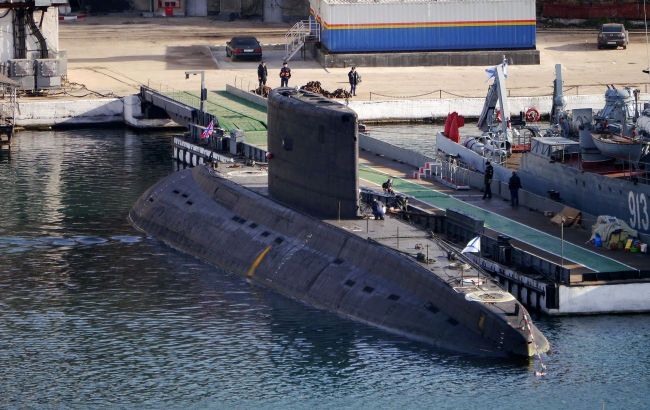Historic strike: How Ukraine managed to hit a Russian submarine and will the Rostov sail again
 Ukraine struck the Russian submarine Rostov-on-Don with a cruise missile (Photo: kchf.ru)
Ukraine struck the Russian submarine Rostov-on-Don with a cruise missile (Photo: kchf.ru)
Ukraine has conducted another successful attack on Russian targets in occupied Sevastopol. Presumably, a large landing ship Minsk has been destroyed, but the most intriguing is the striking of the submarine Rostov-on-Don. Find out how the submarine was successfully hit and why this is a unique event in history in RBC-Ukraine's article.
What happened
The night of September 13 in Sevastopol was tumultuous. Eyewitnesses reported several powerful explosions, and later it became known about a fire in the Southern Bay on the territory of the Sevastopol Shipyard named after Ordzhonikidze. This is the main site for the repair and construction of vessels for the Russian Black Sea Fleet.
Local Telegram channels reported on flights and fires in the parking areas of military ships and submarines. They also published photos and videos from the scene.
The occupying authorities reported a Ukrainian attack and a fire in the Kilen-balka area, where the 13th Ship Repair Plant is located. Simultaneously, sounds of gunfire and new explosions were heard in Sevastopol. Panic gripped the city, and according to unofficial information, the police were dispatched to search for saboteurs, and in one incident, the occupiers opened fire on their own.
In the morning, the Russian Ministry of Defense claimed a supposed strike of 10 missiles on Sevastopol Shipyard. Three of them hit their target, confirmed by satellite images showing areas of fire in the Southern Bay. It was also claimed that three unmanned boats had been destroyed.
Officially, the Russian side acknowledged damage to two ships that were under repair in dry docks. Subsequently, Telegram channels clarified that these were the diesel-electric submarine Rostov-on-Don and the large landing ship Minsk.
There were reports of two fatalities and 26 injured. According to the ForPost article, none of them were employees of Sevastopol Shipyard.
As of the afternoon, Minsk was still on fire. OSINT project Oryx analysts concluded that it was not just damage but the complete destruction of the dock landing ship.
This is the third large landing ship to be struck since the full-scale invasion by Russia. Prior to this, in March 2022, Ukrainian forces destroyed the Saratov landing ship in the Russian-occupied Berdyansk, and in August 2023, a surface drone incapacitated the Olenegorsky Gornyak landing ship near Novorossiysk.
However, the case with the submarine was truly unique. Not only for Ukraine but in the history overall.
Rostov-on-Don diesel-electric submarine: What's known about the submarine
This is a diesel-electric submarine of the 636.3 Varshavyanka project. It's part of the 4th Separate Brigade of Submarines of the Russian Black Sea Fleet and was named after the Russian city of Rostov-on-Don.
The submarine was laid down in 2011 at the Admiralty Shipyard in St. Petersburg, and in 2014, it was launched into the water and eventually assigned to the Black Sea Brigade based in Novorossiysk.
"Rostov-on-Don is one of six submarines of the 636.3 project. It's a new submarine built after Russia's annexation of Crimea. Currently, there are four of them in the Black Sea and two in the Mediterranean. There's also the seventh, Novorossiysk, but it's essentially not operational and has never been on combat duty, remaining under perpetual repair," explained military naval expert and Defense Express observer, Volodymyr Zablotskyi, to RBC-Ukraine.
The submarine Rostov-on-Don was involved in military actions even before the invasion of Ukraine. In 2015, it conducted missile strikes against ISIS targets in Syria from the waters of the Mediterranean Sea.
Zablotskyi notes that Russian submarines in the Black Sea take turns going on combat missions to strike Ukraine. Rostov-on-Don was no exception.
"It carries six torpedoes or four Kalibr missiles (sea-launched cruise missiles - Ed.) in a single salvo. Let's consider that now the Russians are minus four Kalibr missiles. It seems they have lost one missile carrier, at least partially, for several months," he emphasized.
Characteristics of the submarine
- Displacement: 2,350 tons (surfaced) and 3,950 tons (submerged)
- Length: 73.8 meters
- Beam: 9.9 meters
- Draft: 6.2 meters
- Speed: 11 to 17 knots on the surface (20 to 31 km/h) and up to 20 knots submerged (37 km/h)
- Operational depth: 240 meters
- Maximum depth: 300 meters
- Endurance: 45 days
- Crew: 52 personnel (including 12 officers)
- Armament: 8 anti-aircraft missiles (SAMs) and four Kalibr missiles
- Approximate cost: $300 million
Ukraine is behind the strike
Earlier in the morning, the Defense Intelligence of the Ministry of Defense of Ukraine, in a comment to RBC-Ukraine, confirmed the damage to a large landing ship and a submarine in Sevastopol.
"There is damage to the Sevastopol Shipyard named after Sergo Ordzhonikidze in Sevastopol, including its equipment. As for watercraft, we can confirm the damage to a large landing ship and a submarine," the intelligence agency reported.
Further, the Centre for Strategic Communications reported on the successful strikes by the Armed Forces of Ukraine on the Russian fleet and infrastructure in the Ship Bay. And the Commander of the Air Force, Mykola Oleshchuk, hinted at what exactly they were doing.
"While the occupiers are still 'storming' and they are still coming to their senses from the night's explosions in Sevastopol, thanks to the pilots of the Air Force of the Armed Forces of Ukraine for their excellent combat work. To be continued," he wrote on his Telegram.
It is noteworthy that the general used the word "storming" and clearly referred to Storm Shadow air-to-ground missiles, which are not being used for the first time to strike Russian objects.
The corresponding information, citing Ukrainian and Western officials, is also provided by the British channel Sky News. But with the note that Storm Shadow missiles were used "in a significant attack against the headquarters of Russia's Black Sea Fleet."
Why this is a unique case
The striking of a submarine is a unique situation because Ukraine does not have standard capabilities for this. A submarine is a complex target in itself, and detecting and destroying it requires a whole range of resources.
For instance, to detect a submarine, you need your own submarine fleet, anti-submarine ships, planes, and helicopters. Volodymyr Zablotskyi reminds us that a portion of our aviation was seized in Crimea. But even before that, it was not sufficiently numerous because Ukraine did not plan to fight against the Russian Black Sea Fleet, let alone submarines.
"In general, according to the genre classics, submarines are targeted at their bases. Probably, we made an attempt to attack in November 2022 in Novorossiysk, back then our drone was shot down, but apparently, it was just a trial run," he told RBC-Ukraine.
Submarines are underwater only when they are on combat missions; the rest of the time, they are in surface position, where they refuel and undergo maintenance. The submarines of the Black Sea Fleet of the Russian Federation are based in Novorossiysk and visit Sevastopol for missiles.
"By the way, it is on the southern site of Sevastopol Shipyard that they load up with Kalibr missiles. They can be seen from space, reconnaissance drones spot them, and likely, Western partners provided the coordinates, and we managed to get Rostov-on-Don. What the British and Americans used to do with bombs during World War II, we did with aviation missiles. It's what we have," the expert believes.
Therefore, hitting a submarine with an air-launched missile is unique not only for Ukraine but also in general, as it has been realized for the first time in history.
"Usually, submarines in submerged positions are targeted with depth charges. But with air-launched missiles while the submarine is in dry dock? Such cases have never occurred," Zablotskyi added.
The specialized portal Defense Express notes that the Storm Shadow has a warhead weighing 450 kg, consisting of two parts. Initially, the cumulative charge pierces the obstacle, after which the main fragmentation-fuze part flies into the opening formed. Therefore, the fire on the Rostov-on-Don most likely means the final disabling of the submarine.
Possible consequences
The strikes on military objects in Sevastopol are already being discussed in high-level offices. According to the advisor to the head of the President's Office, Mykhailo Podolyak, today's events demonstrate that the Armed Forces of Ukraine are increasing their capabilities, particularly regarding the demilitarization of the Russian Black Sea Fleet.
He also emphasizes that demilitarization will be a real guarantee of security for trade routes and the grain corridor in the Black Sea.
"This is the only correct response to Russia's attempts to turn hunger into a weapon and the only way to ensure uninterrupted grain supplies to the countries of the East and Africa," Podolyak stated.
_1.jpg) Photo: After the strike on Rostov-na-Donu, the missile carriers are unlikely to be withdrawn from Crimea (mil.ru)
Photo: After the strike on Rostov-na-Donu, the missile carriers are unlikely to be withdrawn from Crimea (mil.ru)
Hoping that the nighttime attack has scared Russia into withdrawing missile carriers from Crimea is premature.
"Minus one submarine carrier means minus four launchers for Kalibr missiles. However, last month the Russians introduced the missile ship Cyclone, which carries 8 Kalibr missiles. So, it's a plus-minus situation, and no one said the attacks would stop. I believe there will be others," said expert Volodymyr Zablotskyi in a comment to RBC-Ukraine.
However, regarding the liberation of Crimea, the destruction of the Minsk landing ship is considered by experts to be more promising. According to him, the adversary has lost another platform that was used for troop transfer and military logistics.
"When the Crimean Bridge is no more, and it will eventually be blown up, Crimea will effectively become an island. The fewer ships Russia has, the more difficult it will be to ensure the movement of goods. Let's remember World War II. No matter how heroically Sevastopol held out, as soon as the Germans blocked it from the sea, all resistance ceased," he concluded.

